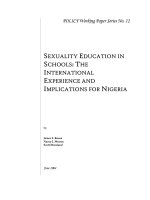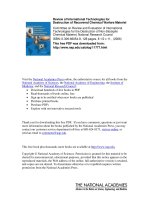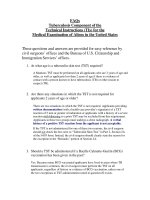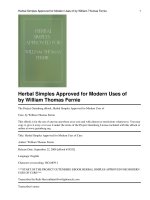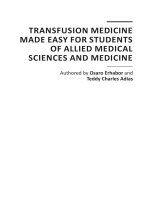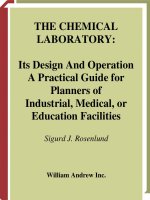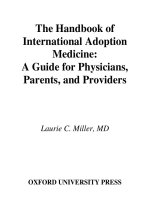Oversight of international medical schools approved for long-term clinical clerkship placements
Bạn đang xem bản rút gọn của tài liệu. Xem và tải ngay bản đầy đủ của tài liệu tại đây (130.25 KB, 13 trang )
THE STATE EDUCATION DEPARTMENT / THE UNIVERSITY OF THE STATE OF
NEW YORK / ALBANY, NY 12234
TO:
The Professional Practice Committee
FROM:
Frank Muñoz
SUBJECT:
Oversight of international medical schools approved for
long-term clinical clerkship placements
DATE:
November 2, 2010
STRATEGIC GOAL:
3
AUTHORIZATION(S):
Summary
Issue for Discussion
The purpose of this item is to discuss, with the Professional Practice Committee,
recommendations for the continued oversight of the didactic and clinical education of
international medical schools who seek to place their students in New York State
hospitals for long-term clinical clerkships.
Reason(s) for Consideration
Review of Policy.
Proposed Handling
This item will be presented for discussion and guidance at the November
Professional Practice Committee meeting.
Procedural History
In response to expressed concerns, as well as a commitment to continually
review regulations for current relevancy, the Office of the Professions convened an
International Medical Schools Study Group, with the Regents consent. The purpose of
this group is to provide the Board of Regents with information, perspective, and
recommendations for continued oversight over the didactic and clinical education of the
international medical schools that have been approved for long-term clinical clerkships.
The Study Group is comprised of representatives from the Department of Health,
hospital associations, New York State medical schools, New York State hospitals, and
international medical schools, and others. Staff from the Legislature and the Governor’s
Office has been invited to observe the discussions. Over several meetings, the Study
Group identified key data points and topics for consideration and discussed proposed
recommendations (See Attachment for original outline of purpose).
Background Information
The Board of Regents has broad authority to regulate medical education and
licensure for the practice of medicine. Exercise of that authority, including the
evaluation and approval of the didactic and clinical medical education, is set out in Part
60 of the Commissioner’s Regulations. Section 6524 of Education Law contains the
licensing requirements for physicians. Those requirements include passing the relevant
licensing examination and obtaining education acceptable to the Department. As part of
the necessary education, medical students typically complete approximately 72 weeks
of clinical clerkships to gain the total needed for licensure.
Domestic medical students usually pursue their clinical training in affiliated
hospitals within the state in which the school is located. However, in the last 20 years,
there has been a proliferation of “dual-campus” medical schools, commonly referred to
as “offshore” medical schools. A dual-campus medical school is one in which the first
two years of didactic education are completed in a foreign country, typically the
Caribbean. Generally, the final two years of clinical education are completed in affiliated
hospitals in the United States, but not exclusively, in New York State.
Part 60.2 of Commissioner’s Regulations require the evaluation and approval of
“dual-campus” international medical schools who wish to place students in NYS
hospitals for clinical clerkships for more than 12 weeks (long-term clinical clerkships).
Currently, to be “approved,” the school must submit an application to the Department,
undergo a site visit and meet the requirements of Part 52 of the Commissioner’s
Regulations. The site visitors (Executive Secretary and four consulting physicians with
experience in medical education) evaluate the physical plant, library, student support
services, admissions criteria, curriculum, faculty, financial viability, etc. The review also
includes a visit to affiliated hospitals in New York State to ensure that there is adequate
supervision of students from that dual-campus school and alignment of the clinical
experience with the objectives of the school.
These “approved” schools enter into affiliation agreements with New York
hospitals to secure clinical clerkship spaces for their students. The agreements provide
that the school will pay a fee for each student who undertakes a clinical rotation.
Concerns from domestic medical schools that their students will be squeezed out of
clinical training opportunities have been reported to the Department.
Students admitted into dual-campus schools tend to have lower GPAs and
Medical College Admissions Test (MCAT) scores than their counterparts do in domestic
medical schools; indeed, most international medical schools do not require students to
take the MCAT. Concern has also been expressed about the quality of students
admitted into dual-campus schools. There is evidence, however, that the more mature
dual-campus schools admit students with very competitive academic backgrounds. It
appears that many of these students were not granted admission to domestic schools
because of the limited number of available seats. Regardless of the point of entry
criteria and issues related to determining student preparedness to undertake the study
of medicine, aspiring physicians must ultimately satisfy all of the requirements for
licensure to be able to practice in New York State.
International Medical School graduates comprise approximately 36% of the New
York State physician workforce. A significant portion of these physicians was educated
at “dual-campus” international medical schools.
Currently, 14 international medical schools are approved for long-term clinical
clerkships. In recent years, many existing dual-campus schools have expanded
their student population. NYSED continues to receive applications for the approval of
new schools. The regulations for such clinical approval were developed in 1981, and
have not been modified since 1985. To keep current with medical education today,
the regulations should be reviewed to determine if they are still appropriate to ensure
fulfillment of the Regents responsibility for the general supervision of educational
activities within the State.
Section 6524 of the Education Law grants the Board of Regents broad authority to
regulate medical education and the practice of medicine. Exercise of that authority
is reflected in Part 60 of the Commissioner’s Regulations. The following factors are
addressed in those implementing regulations:
1.
2.
3.
4.
5.
Pre-professional education
Length and curriculum content of professional education
Degree to be awarded
Examination requirements
Clinical training requirements including:
- who may perform clinical training in NYS
- the duration of such clinical training
- where such clinical education may be conducted
6. Experience requirements
7. Post-graduate training requirements
The Board of Regents has the authority to amend or waive any of the enumerated
factors.
STUDY GROUP
In response to expressed concerns and its commitment to continually review
regulations for current relevancy, and with the Regents consent, the Office of the
Professions convened a Study Group to provide the Board of Regents with information,
perspective, and recommendations for continued oversight over the didactic and clinical
education of the 14 dual-campus International Medical Schools that have been
approved for long-term clinical clerkships. Numerous meetings have taken place over
the last several months, beginning with research and internal meetings in late spring.
Meetings with stakeholders were held throughout, including:
7/2/10 – Discussion with the NYS Department of Health and Associated Medical
Schools of New York State (AMSNY), Albany, to discuss their concerns related to
the impact of the contracts and SED’s role in overseeing the quality of International
Medical School education and clinical clerkships
7/29/10 – Stakeholder meeting, NYC, to solicit suggestions and recommendations
for the direction of the Study Group
8/26/10 – SED, DOH, Greater New York and HANYS, to discuss stakeholder
recommendations and next steps.
9/21/10 – Briefing with Regent Norwood, SED and Dr. Oskvig, Chair, NYS Board for
Medicine
9/28/10 – Study Group Meeting #1, NYC, to discuss factors for evaluation
(demographics and educational quality) and to reach preliminary recommendations
for Regents action
10/28/10 – Study Group Meeting #2, NYC, to present and discuss conceptual
recommendations from the Board for Medicine and the Office of the Professions
RECOMMENDATIONS FOR REGENTS CONSIDERATION
Following these meetings, we asked a State Board subcommittee for a series of
recommendations regarding: a) comparable standards for education and oversight over
the clerkships and other factors that have been discussed b) the process utilized for
review of applications for students to do 12 weeks+, and c) the structure, OP capacity,
and clarity and transparency of the evaluations, including doing cross-walks from
current "administrative assumptions and guidelines" to definitive articulations of the
expectations and process in Commissioner’s Regulations.
The State Board subcommittee outlined recommendations that would integrate
the suggestions made during the various meetings and the goal of ensuring comparable
standards that could be utilized within an oversight system capable of implementing and
monitoring the standards. While arguments have been made that the current standards
and regulations are sufficient for robust and efficient oversight, that argument is
unpersuasive when the Medical Board Office is operating with approximately 50% of
staffing of several years ago and substantially increased workload and responsibility.
Simply stated, we are incapable under the current structures and processes of efficiently
discharging the oversight responsibility, especially when the standards lack specificity
and thus consistency when implemented with severe staffing shortages. OP leaders,
Tom Burke, and Dr. John Morley from the Department of Health discussed the
recommendations. Based on those discussions, we plan to develop and present in
November three central initial recommendations for Regents discussion and guidance
that address structure, process, and transparency.
I.
Structure: Key responsibilities should be delegated to an entity that would add
specific expertise, transparency, consistency, and independence to evaluations of
applications from the dual-campus schools and the continued acceptance of
didactic education leading to licensure. We suggest for consideration the creation
of a sub-committee of the Medical Board specifically appointed by the Regents to
discuss and review the applications for clerkship approvals and recommend
whether the application sufficiently addresses applicable standards to merit a site
visit, which will continue to be conducted by the State Medical Board.
The current regulations can be revised to require that the Committee on the
Professions (COP) or the Deputy Commissioner for the Professions review the
recommendations from the site visit; the COP or the Deputy Commissioner will in
turn make a recommendation to the Board of Regents for decision. This is a
substantial departure from the current system, which does not involve the Regents
review, and relies on the understaffed Medical Board office for the evaluation of
data, the site visit, and every other related responsibility. The subcommittee will also
apply the applicable comparable standards (see II below) regarding the acceptance
of education from the dual-campus schools that seek Regents approval for the
clerkships.
II. Comparable Standards: During the discussions within the Study Group on
International Medical schools there has been consensus that the evaluation of
international medical schools who seek approval to operate in New York State
should be consistent and based on standards that are comparable to the standards
utilized by the Liaison Committee on Medical Education (LCME) in evaluating
domestic medical schools.
The current regulations regarding the evaluation of international medical programs
specifically incorporate the standards enumerated in Part 52 for accredited and
registered programs. The Guide for Unregistered Medical Schools Seeking
Approval To Operate in New York State, published by the Board for Medicine,
incorporates, by reference, the standards of the LCME. However, the Part 52
standards do not provide sufficient specificity and guidance. The LCME standards,
on the other hand, provide more clearly articulable and objectively measurable
standards.
The substantial variation in programs that have been approved thus far and
evidence of inconsistent adherence with recommendations made by site visit teams
suggests that the process for ensuring the implementation of the guidance provided
by Part 52 of the Commissioner’s Regulations and the standards of the LCME must
be strengthened. Accordingly a subcommittee of the medical board was asked to
explore methods by which the evaluation of international medical schools would be:
Governed By Objectively Measurable Standards,
Consistently Applied Standards
Professionally Developed Remediation Plans And
Rigorous Enforcement
Demonstration of Continuous Curriculum Improvement
Among the factors that may be considered are by the sub-committee, openly and
collaboratively discussed and approved by the Regents within its regulatory process
are:
a. School performance be measured by reference to national averages on
generally
b. accepted outcome measures (USMLE STEP 1, STEP 2, ECFMG)
c. Student performance be measured by a uniform nationally accepted
standard
(NBME course exams, NBME cumulative exams etc.)
d. Didactic and Clinical faculty qualifications be specifically articulated
e. Out-of-State Clinical clerkships for approved schools comply with NYS
requirements.
f. Clinical Student to Faculty ratios be established
g. Resource standards (labs, microscopes, cadavers etc.) be established on
a ratio to students
h. Specific Curriculum requirements be established.
i. Establishment of a Regents Appointed review team for initial review of
data submissions by schools seeking approval.
j. Recommendations for “Approval” be submitted to the Board of Regents.
III. Transparency: Currently, the ability of the NYSED to approve students at programs
offered by international medicals to complete clerkships greater than twelve weeks
is gained largely from a general regulatory authority. However, that authority lacks
specificity and the process for determining which schools are acceptable is almost
totally determined by internal administrative guidance. As a result, the process
employed and the standards that govern are subject to a lack of formality and
difficult to ascertain with respect to specificity. Accordingly, a regulatory structure,
adopted by the BOR, would establish a clear and equally applied process that could
be understood by all of the impacted parties. Understanding that the current
process lacks transparency, we believe that the implementation of a regulatory
structure outlining the method of approval, the factors to be considered and the
process of approval will add a strong level of fair oversight as we continue to
advance the Regents oversight of medical education.
Timetable for Implementation
The conceptual changes have been shared with the stakeholders. Based upon
the Committee’s guidance, we will return to the Committee with proposed regulations
addressing the issues identified above.
STUDY GROUP ON INTERNATIONAL MEDICAL SCHOOLS
STUDY FOCUS:
This study will provide the Board of Regents with
information, perspective, and recommendations for continued oversight over
the didactic and clinical education of the 14 dual-campus International Medical
Schools that the Regents have approved for purposes of long-term clinical
clerkships.
Section 6524 of the Education Law contains the licensing requirements for
physicians. Those requirements include passing the relevant licensing examination
and obtaining education acceptable to the Department. As part of the necessary
education, medical students typically complete approximately 72 weeks of clinical
clerkships to gain the total needed for licensure. The Board of Regents has broad
authority to regulate medical education and licensure for the practice of medicine.
Exercise of that authority, including the evaluation and approval of the didactic and
clinical medical education, is set out in Part 60 of the Commissioner’s Regulations.
The Part 60 regulations require the evaluation and approval of “dual campus”
international medical schools who wish to place students in NYS hospitals for clinical
clerkships for more than 12 weeks (long-term clinical clerkships).
International Medical School graduates comprise approximately 36% of the New
York State physician workforce. A significant portion of these physicians were
educated at “dual campus” international medical schools – medical schools whose
students receive their didactic education in the country where the school is located
outside of the United States, but whose clinical education is completed elsewhere,
often at NYS hospitals.
Currently, there are 14 international medical schools that are approved for long-term
clinical clerkships. In recent years, many existing dual-campus schools have
expanded their student population. NYSED continues to receive applications for the
approval of new schools. The regulations for such clinical approval were developed
in 1981, and have not been modified since 1985. Some have raised concerns as to
whether existing laws and regulations related to medical education adequately serve
to ensure fulfillment of the Regents responsibility for the general supervision of
educational activities within the State.
FACTORS FOR EVALUATION
I. Demographics
1. Current and Projected Demand and Workforce Demographics
a. Population of Medical Students
(i) LCME (Liaison Committee on Medical Education)/COCA (Commissioner
on Osteopathic College Accreditation) accredited medical schools
(ii) Dual-campus international medical schools
(iii)
Rate of growth (10 years) in each category
b. Number of clinical clerkships utilized annually
(i) LCME/COCA accredited medical schools
(ii) Dual-campus international medical schools
(iii)
Other international medical schools
c. New York Residencies (Post-Graduate Trainees - PGTs)
(i) Current number of seats
(ii) Number of applicants
(iii)
Rate of increase in demand (10 years)
(iv)
Number of seats occupied by dual-campus International Medical
Graduates (IMGs)
(v) Areas of specialization
(vi)
Trends in dual campus-IMG resident placement
(vii) Number of unfilled residency seats
(viii) Area of specialization of unfilled residency seats
(ix)
Number of “transitional” and preliminary residency placements in
NYS
(a) By LCME/AOA graduates
(b) By dual-campus international medical school graduates
(c) By other IMGs
d. Practicing Physicians (i.e., number of registered practicing physicians in NYS,
including the numbers for primary care providers and significant specialty
practitioners, number of those practitioners expected in NYS in the next ten
years, impact of limited license and citizenship requirements on geographical
area of practice)
II. Educational Issues
1. Acceptable Professional Education:
a. Role of LCME /COCA
b. Equivalency:
(i) ECFMG
(ii) CCAM-HP
(iii)
USDE Title IV Funding Approval
(iv)
Other
2. Structural Comparisons
a. Admission Standards (average MCAT, GPA, etc.)
b. Faculty Qualifications (credentials and prior number of years teaching,
professional practice and research)
c. Curriculum (pre-clerkship didactic)
d. USMLE Step 1 scores
e. Exit data USMLE Step 2 scores
f. Faculty/student ratios
g. Diversity/profile of student population
h. Cost/tuition
3. Clinical Clerkships
a. Where are clinical clerkships performed
(i) LCME accredited schools
(ii) Dual-campus international medical schools
b. Number and fill-rate of available slots
c. Capacity to expand clinical clerkship seats
d. Clinical clerkship standards
(i) Uniformity of experience
(a) “Green Book (ACGME)”
(b) “Blue Book (non-ACGME)”
(ii) What is the clerkship curriculum?
(iii)
How are students evaluated?
(iv)
Are (ii) & (iii) defined by school or ad-hoc by location?
(v) How does the school do quality oversight of the clerkship experience?
(vi)
Is there student feedback, where does it go?
e. Associated Costs
(i) Direct and indirect reimbursement
(ii) Financial impact on hospitals
f. Exclusivity arrangements (affiliation agreements that exclude students from
other international schools)
(i) Regents intent to share NYS educational assets
g. Number of clerkships in NYS vs. other jurisdictions
h. Impact of clinical clerkships on LCME/COCA-accredited slots
4. Performance Outcomes
a. Graduation Rates
b. USMLE Pass Rates
c. Retention Rates
d. Additional Measures
5. Practice Environments
a. Do Graduates obtain NYS licensure?
b. Where Do Graduates Practice?
(i) NYS vs. other jurisdictions
(a) If NYS, Primary Care and Non-primary Care?
(b) If NYS, Underserved Areas?
6. Practice Performance
a. Disciplinary/patient outcome data re: international medical graduates of dual
campus programs
III. Board of Regents
1. Board of Regents Statutory Oversight Authority
a. Licensure Regulations
b. Approval standards for clerkships
2. Possible Recommendations to the Regents. Depending on discussions and
factors researched/collected, the recommendations can range from maintaining
current oversight to initiating some or all of the following, in addition to others that
the Study Group may recommend; however, the recommendations need to be
limited to the limitations of Regents jurisdiction:
a. Maintain Status Quo
b. Amend licensure regulations
(i) Pre-professional education requirements
(ii) Professional education requirements
(iii)
Licensure eligibility based on recognition by civil authority (for
international medical schools generally)
(iv)
licensure eligibility based on curriculum content
c. Amend clinical clerkship approval requirements
(i) Students Qualifications
(a) MCAT required (Admissions committee determines weight to be
accorded. Serves as source of data comparative data)
(b) Minimum GPA
(c) Other
(ii) Student Assessment
(a) NMBE Subject Shelf Exams using raw scores
(b) NBME Cumulative Shelf Exams using raw scores
(c) Other
(iii)
Faculty Qualifications
(a) Basic Sciences Faculty:
i) Minimum Academic Degree 1) Masters Prepared
o Years of teaching experience at Graduate Level
2) PhD. Prepared
o Years of teaching experience at Graduate Level
3) Other factors for consideration
(b) Clinical Science Faculty:
i) Minimum Academic Degree 1) M.D./MBBS etc. Degree
2) Licensure
3) Practice Experience:
a. Verified Practice Experience in Particular Subject ( 2 +
Years)
b. Board Certification in particular subject
c. Percentage of clinical science faculty with American practice
experience
(iv)
Clinical Clerkships
(a) USMLE Step 1 required before start of clinical rotations anywhere (not
limited to NYS)
(b) Clinical Rotations under subject specific ACGME/AOA residency
auspices anywhere (No “Blue Book” Residencies)
(c) Adoption of Standardized Clinical Clerkship Evaluation Form
(d) Specified Clinical Preceptor/Student ratio
(e) Annual Site Visit of each “Affiliated Hospital” with report to School and
NYSED by Clinical Dean/Director
(f) Annual Report by Hospital of Affiliated Schools and Annual Student
Participation in Clerkship Program – Requires DOH approval
(g) Elimination of Exclusive Affiliations for continued “Approval” (12 week
or less rotations permissible in keeping with Regents intent)
d. Amend dual-campus international medical school oversight
(i) Possible limitations
(a) Number of approved schools
(b) Growth factors that require notice and authorization for continued
approval
i) Growth of more than 10-15% since last site visit
ii) Establishment of branch campuses
(ii) Re-review process triggers
(a) Frequency
(b) Expansion
IV. Study Group Members
Frank Muñoz, Deputy Commissioner, OP, NYSED
Roger K. Oskvig, M.D., Chair, State Board for Medicine
Walter Ramos, Executive Secretary, State Board for Medicine, NYSED
Leonard Lapinski, Director, Professional Education, NYSED
Douglas Lentivech, Assistant Counsel, NYSED
Sarah Benson, Legislative Coordinator, NYSED
John Morley, M.D., Medical Director, New York State Department of Health, Office of
Health Systems Management
Tom Burke, New York State Department of Health, Council on Graduate Medical
Education
Jo Wiederhorn, President/CEO, Associated Medical Schools of New York (AMSNY)
Michael J. Reichgott, M.D, Associate Dean for Clinical Affairs and Graduate Medical
Education, Albert Einstein College of Medicine
Jerry Balentine, D.O., Senior Vice President, Chief Medical Officer, St. Barnabas
Hospital/NYS Board for Medicine
Barbara Ellman, Associate Director for Policy, Medical Society of the State of New York
(MSSNY)
Tim Johnson, Senior Vice President, Greater New York Hospital Association (GNYHA)
Frederick Heigel, HANYS
Luis Marcos, M.D., Medical Director of Affiliations, NYU School of Medicine/NYS Board
for Medicine
Jean Moore, Director, Center for Health Workforce Studies, SUNY Albany
Barbara Ross-Lee, D.O., Vice President, New York Institute of Technology
Steven J. Walerstein, M.D., FACP, Medical Director, Nassau University Medical Center
Steven Scheinman, M.D., Dean, College of Medicine, Senior Vice President, SUNY
Upstate Medical University
Lawrence Smith, M.D., Hofstra University School of Medicine
Harris M. Nagler, M.D., FACS, President, Beth Israel Medical Center
Pamela Cooper, Ben-Gurion University of Negev
Jerry Jacob, M.D./Tarik Elibol, Hope Medical Institute
Cynthia Holden, Esq., American University of the Caribbean
Fred Jacobs, St. George’s University
Ricardo Leon, M.D., Vice-President of Health Sciences, University of Guadalajara
Nancy Perri, Ross University
Steve Rodger, 3R Education
Neal Simon, American University of Antigua
NYSED-approved dual-campus international medical schools:
American University of Antigua, Antigua
American University of the Caribbean, St. Martin, Netherland Antilles
The Autonomous University of Guadalajara, Guadalajara, Mexico
English Language Program, University of Debrecen, Medical and Health Science
Center, Medical School, Debrecen, Hungary
English Language Program, Medical University of Lublin, Lublin, Poland
English Language Program, Medical University of Silesia, Katowice, Poland
Fatima College of Medicine, Manila, Philippines
International Health and Medicine Program, Ben Gurion University of the Negrev,
Beer-Sheva, Israel
Kasturba Medical College, Manipal, India
Medical University of the Americas/Nevis, Nevis, West Indies
Ross University School of Medicine, Roseau, Dominica
Saba University School of Medicine, Saba, Netherlands Antilles
St. George’s University School of Medicine, St. George’s, Grenada
St. Matthew’s University School of Medicine, Grand Cayman, Cayman Islands

